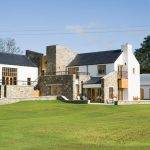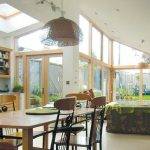There is a wide range of insulation materials available with a render finish: white and grey expanded polystyrene, extruded polystyrene (in areas where water is in continuous contact with the insulation), mineral wool, phenolic, polyisocyanurate, cellulose fibre, etc.
Apart from rendered coats, the choice has now widened to take in a variety of commercially available claddings, including lightweight natural stone aggregate, brick, tiles and decorative weatherboarding. Such systems are called rainscreen cladding systems and they have a 25mm ventilated layer between the insulation and the cladding boards. It is a simple, speedy process which is particularly ideal for providing a traditional external appearance to a concrete block or framed construction.
Insulating externally in NI and ROI has been slow in comparison to European countries, where it has been used for decades on both new and refurbished buildings. Initial damage caused by thermal movement, concrete decay or deterioration of the external leaf due to cavity filling have now largely been eradicated.
An insulated render:
- insulates external walls providing the desired ‘U’ value without the risk of condensation associated with dry-lining
- allows the fabric of the building to act as a heat store, increasing thermal efficiency, preventing cold bridging, condensation and mould growth
- provides a decorative external envelope, giving lasting weather resistance
- stabilises the structural fabric preventing movement due to thermal shock
- contributes to sound reduction
Natural Stone
As a building material, stone has stood the test of time for its beauty and permanence. It includes marble, granite, limestone and sandstone.
Marble is very durable, easy to maintain when sealed and is available in either a gloss, honed or hammered finish. Gloss gives a sheen, honed a matt and hammered a rough textured finish.
[adrotate banner="58"]Granite is harder than marble and has a different look; it is very pixellated, whereas marble has more fluid lines. Both materials are fairly low maintenance in terms of cleaning and their costs similar.
Limestone is softer than both granite and marble and looks great if you don’t want a ‘busy’ pattern. As with the previous two stones, it has to be sealed. With limestone you can get two cuts, either along the grain for a streaky effect or across it for a more textured appearance. Sometimes there are little holes in the stone, similar to a ‘Swiss cheese’ effect, which can be filled with resin or left for a more natural look. Limestone is available in a variety of colours, from golden yellow, deep taupe to neutrals and greys. It is possible to source blues and reds but these more elaborate colours are expensive.
All of the above are now used as external cladding materials as building in solid stone, other than in a restoration situation, will not provide the thermal or moisture resisting qualities required by current legislation. You will also require the skilled services of a specialist stonemason, a labour intensive and costly item. In a new build they are most commonly found as ready made panels of stone slips which can be fixed to both block and timber frame exteriors, giving the impression of a solid wall externally, and because of the deeper window reveals internally. However, it does have a uniformity which is not always acceptable to every situation. (See ‘Panels’ below).
A recently launched alternative is the ability to cut slices of stone 40mm thick which are individually placed on the block wall using adhesive, with the finished work pointed. The result is a wall that looks solid stone but at a fraction of the cost.
Reconstituted Stone
This is made by crushing natural stone: refined clays, quartz, feldspars and metal oxides. Water is added to the powder mix which is then pressed and goes through a vitrifying process (1,200°C). It results in slabs with a virtually zero porosity (100 times less than natural stone), making these extremely frost resistant and anti-graffiti without extra coating. Reconstituted stone is not bonded with artificial components and does not include artificial colouring or materials. This material is not load bearing, but is instead used as an external cladding similar to facing brick or natural stone, fixed with an adhesive to a plastered wall or used in a rainscreen system. Because it has a more uniform texture and colouring, reconstituted stone is not an exact substitute, but it is cheaper and easier to work with. The latter is due to its flexibility, allowing more complex shaping and joining; it is also very durable.
Panels
Stone panels are an innovative design in the development of walling systems for both new build and refurbishment. The panels, which can be as little as 30mm thick, can be used as a structural restraint wall for traditional brickwork or stone, and can be prepared to receive renders, terracotta and a range of other facades.
A latest development in this category of products has been the availability of large dimension terracotta tiles in sizes of up to 3,000mm by 750mm.
Their main advantage is that they offer speed of construction and cost effectiveness. Due to their lightweight, they are extremely easy to handle, so an entire building can be laid out in advance allowing blending of the colour and natural stone grain prior to fabrication and installation. Currently, it is standard practice for the finishing elements to be applied on site although developments are being made in the manufacture of composite units.
Natural stone-faced precast concrete panels are concrete units, which have been faced with any type of natural stonework. This allows the self builder to combine a traditional natural stone appearance with the durability of precast panels. They are also quicker to build with, in large part because they are not affected by the weather.
Reconstituted stone precast concrete panels are concrete units where a specific concrete mix has been designed to resemble natural stone (see reconstituted stone above). A wide range of natural stones can be imitated – such as Portland stone, Stainton stone or red terracotta – and there are a variety of finishes, including acid-etched, smooth or coarse ground, grit or sand-blasted, rubbed or polished.
Reconstituted stone can be successfully combined with natural stone-faced panels – using the natural stone on lower levels or on more visible elevations and the reconstituted on higher levels.


